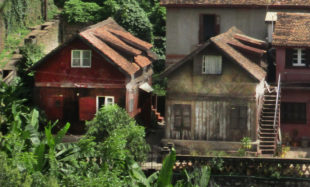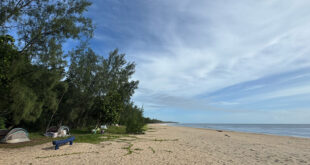In the upper town of Antananarivo, you can find today the historical center of the city, Faravohitra. The two oldest houses of the city are also located in this district. They are located somewhat inconspicuously on a hillside. Both houses were built exactly as they still stand today, probably already at the end of the 18th or the beginning of the 19th century under King Andrianampoinimerina. The building material at that time was wood, probably rosewood or some other durable tropical wood. The architectural style is called kotona: heavy wooden piles are placed at all four corners as well as in the middle of two sides and exactly in the middle of the house, supporting the basic structure with the gabled roof. The walls are made of wooden planks.
Initially, the houses were probably used to store weapons and gunpowder under King Radama I. Only under Queen Ranavalona did the houses of Antsahatsiroa become more important. In order to understand the history of the two houses and their famous inhabitants, one must delve a little deeper into the history of the Merina people.
In 1817, King Radama I. had agreed in a contract with England that 20 young Madagascans should be educated in Mauritius and in England by the London Missionary Society (LMS). The 20 boys were personally chosen by King Radama I and came from families that were very close to the royal court. In addition to their school education, each of them was assigned a specific training in crafts, e.g. in the craft of arms, silversmithing or weaving. Only two boys were later to become court officials – the twins Rahaniraka and Raombana.

On 24.11.1820 the then just eleven-year-olds set off with the ship. They reached London in 1821. For two years, the boys studied at the British and Foreign School Society and the Borough Road School. Afterward, Rahaniraka and Raombana landed at a grammar school in Manchester. At the age of 20, the twins returned to Madagascar in 1829. The vernacular today derisively claims that they had not spoken a word of Malagasy on their return.
But back to the two oldest houses of Antananarivo. They were already standing when Rahaniraka and Raombana returned to Madagascar from England. They were each assigned one of the houses for themselves and their family. The location so close to the Rova (royal palace) of Antananarivo was already something special at the time of its construction: the closer families lived to the Rova, the higher was their prestige and wealth in the city of that time. As planned, Rahaniraka and Raombana first became court clerks, later secretaries at the court of Queen Ranavalona I and tutor to her son, the future King Radama II. Raombana was also the first historian in Madagascar. He wrote detailed reports on all events at the royal court and wrote treatises on the kingdom of Merina. Raombana’s education in England gave him a rather critical view of the work of Queen Ranavalona I. However, he wrote his reports in English, which the Queen and the majority of the court did not understand, thus escaping the watchful eye of Ranavalona I.
Raombana died in 1855. Rahaniraka died seven years later as Madagascar’s first foreign minister under King Radama II, 1862. In Rahaniraka’s footsteps, Raombana’s nephew followed in his footsteps. Around this time the houses of Antsahatsiroa probably got their Creole looking verandas. Also, the interior of the houses was rebuilt: In the originally one-story Merina house, another floor was added, so that the roof functioned as the first floor. Stairs to the top were added and small dormer windows were installed. The appearance of the houses changed due to the conversions, but they were always inhabited by noblemen in the following decades.
Unfortunately, there is still no monument protection for private houses in Madagascar. The preservation and restoration of the historically valuable houses are therefore reserved for their inhabitants. Even today, families who probably belong to the wide family circle of Rahaniraka and Raombana live in the old houses of Antsahatsiroa. A visit is therefore not possible. But if you want to have a look at the two oldest houses of Antananarivo, you can easily do so in the upper town of Antananarivo.
 MADAMAGAZINE Your Magazine about Madagascar
MADAMAGAZINE Your Magazine about Madagascar




